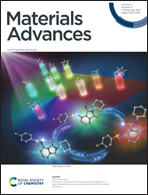A proton conductive hydrogen-bonded framework incorporating 18-crown-6-ether and dicarboxy-o-terphenyl moieties†
Abstract
To date, proton-conducting organic crystalline materials based on crown ethers have rarely been investigated. In this work, we reveal that flexible organic 18-crown-6 derivatives with one or two 4,4′-dicarboxy-o-terphenyl (CT) groups formed four kinds of crystalline frameworks: 1CT-18C6-I (P21/n), 2CT-18C6-I (P![[1 with combining macron]](https://www.rsc.org/images/entities/char_0031_0304.gif) ), 2CT-18C6-II (P
), 2CT-18C6-II (P![[1 with combining macron]](https://www.rsc.org/images/entities/char_0031_0304.gif) ) and 2CT-18C6-III (Cmc21). Single crystal X-ray diffraction analysis clearly suggested that the water molecules were involved a hydrogen-bonded network for two frameworks. In particular, a unique one-dimensional (1D) water pathway had formed in 2CT-18C6-III and the activation energy was evaluated by Arrhenius plots to be 0.14 eV, indicating that the proton jumps from H3O+ to the neighboring H2O in the hydrogen-bonded network of 2CT-18C6-III.
) and 2CT-18C6-III (Cmc21). Single crystal X-ray diffraction analysis clearly suggested that the water molecules were involved a hydrogen-bonded network for two frameworks. In particular, a unique one-dimensional (1D) water pathway had formed in 2CT-18C6-III and the activation energy was evaluated by Arrhenius plots to be 0.14 eV, indicating that the proton jumps from H3O+ to the neighboring H2O in the hydrogen-bonded network of 2CT-18C6-III.



 Please wait while we load your content...
Please wait while we load your content...